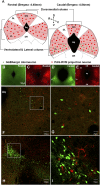T-type channels control the opioidergic descending analgesia at the low threshold-spiking GABAergic neurons in the periaqueductal gray
- PMID: 20682748
- PMCID: PMC2930412
- DOI: 10.1073/pnas.1009532107
T-type channels control the opioidergic descending analgesia at the low threshold-spiking GABAergic neurons in the periaqueductal gray
Abstract
Endogenous opioids generate analgesic signals in the periaqueductal gray (PAG). However, because cell types in the PAG are difficult to identify, its neuronal mechanism has remained poorly understood. To address this issue, we characterized PAG neurons by their electrical properties using differentially labeled GABAergic and output neurons in the PAG. We found that GABAergic neurons were mostly fast-spiking cells and could be further divided into two distinct classes: with or without low-threshold spikes (LTS) driven by T-type channels. In contrast, the PAG output neurons lacked LTS and showed heterogeneous firing patterns. To reveal the function of the LTS, we examined the mutant mice lacking the alpha1G T-type channels (alpha1G(-/-)). The mutant mice lacked LTS in the fast-spiking GABAergic neurons of the PAG and unexpectedly showed impaired opioid-dependent analgesia; a similar phenotype was reproduced in PAG-specific alpha1G-knockdown mice. Electrophysiological analyses revealed functional expression of mu-opioid receptors in the low threshold-spiking GABAergic neurons. These neurons in the mutant lacking LTS showed markedly enhanced discharge activities, which led to an augmented inhibition of output neurons. Furthermore, the impaired analgesia observed in alpha1G(-/-) mice was reversed by blocking local GABA(A) receptors. These results indicate that alpha1G T-type channels are critical for the opioidergic descending analgesia system in the PAG.
Conflict of interest statement
The authors declare no conflict of interest.
Figures








Similar articles
-
Cannabinoids and Opioids Differentially Target Extrinsic and Intrinsic GABAergic Inputs onto the Periaqueductal Grey Descending Pathway.J Neurosci. 2022 Oct 12;42(41):7744-7756. doi: 10.1523/JNEUROSCI.0997-22.2022. Epub 2022 Sep 8. J Neurosci. 2022. PMID: 36414010 Free PMC article.
-
Labetalol facilitates GABAergic transmission to rat periaqueductal gray neurons via antagonizing beta1-adrenergic receptors--a possible mechanism underlying labetalol-induced analgesia.Brain Res. 2008 Mar 10;1198:34-43. doi: 10.1016/j.brainres.2008.01.023. Epub 2008 Jan 18. Brain Res. 2008. PMID: 18262504 Free PMC article.
-
Behavioral evidence linking opioid-sensitive GABAergic neurons in the ventrolateral periaqueductal gray to morphine tolerance.Neuroscience. 2003;118(1):227-32. doi: 10.1016/s0306-4522(02)00822-9. Neuroscience. 2003. PMID: 12676152
-
Cellular actions of opioids and other analgesics: implications for synergism in pain relief.Clin Exp Pharmacol Physiol. 2000 Jul;27(7):520-3. doi: 10.1046/j.1440-1681.2000.03291.x. Clin Exp Pharmacol Physiol. 2000. PMID: 10874510 Review.
-
Progesterone withdrawal-evoked plasticity of neural function in the female periaqueductal grey matter.Neural Plast. 2009;2009:730902. doi: 10.1155/2009/730902. Epub 2008 Dec 2. Neural Plast. 2009. PMID: 19096515 Free PMC article. Review.
Cited by
-
Central and peripheral contributions of T-type calcium channels in pain.Mol Brain. 2022 May 2;15(1):39. doi: 10.1186/s13041-022-00923-w. Mol Brain. 2022. PMID: 35501819 Free PMC article. Review.
-
Yin-and-yang bifurcation of opioidergic circuits for descending analgesia at the midbrain of the mouse.Proc Natl Acad Sci U S A. 2018 Oct 23;115(43):11078-11083. doi: 10.1073/pnas.1806082115. Epub 2018 Oct 8. Proc Natl Acad Sci U S A. 2018. PMID: 30297409 Free PMC article.
-
Inhibitory peptidergic modulation of C. elegans serotonin neurons is gated by T-type calcium channels.Elife. 2017 Feb 6;6:e22771. doi: 10.7554/eLife.22771. Elife. 2017. PMID: 28165324 Free PMC article.
-
Medial septal GABAergic projection neurons promote object exploration behavior and type 2 theta rhythm.Proc Natl Acad Sci U S A. 2016 Jun 7;113(23):6550-5. doi: 10.1073/pnas.1605019113. Epub 2016 May 20. Proc Natl Acad Sci U S A. 2016. PMID: 27208094 Free PMC article.
-
The Ventrolateral Periaqueductal Gray Contributes to Depressive-Like Behaviors in Recovery of Inflammatory Bowel Disease Rat Model.Front Neurosci. 2020 Mar 24;14:254. doi: 10.3389/fnins.2020.00254. eCollection 2020. Front Neurosci. 2020. PMID: 32265648 Free PMC article.
References
-
- Yaksh TL, Yeung JC, Rudy TA. Systematic examination in the rat of brain sites sensitive to the direct application of morphine: Observation of differential effects within the periaqueductal gray. Brain Res. 1976;114:83–103. - PubMed
-
- Reichling DB, Kwiat GC, Basbaum AI. Anatomy, physiology and pharmacology of the periaqueductal gray contribution to antinociceptive controls. Prog Brain Res. 1988;77:31–46. - PubMed
-
- Dostrovsky JO, Deakin JFW. Periaqueductal grey lesions reduce morphine analgesia in the rat. Neurosci Lett. 1977;4:99–103. - PubMed
-
- Lewis VA, Gebhart GF. Evaluation of the periaqueductal central gray (PAG) as a morphine-specific locus of action and examination of morphine-induced and stimulation-produced analgesia at coincident PAG loci. Brain Res. 1977;124:283–303. - PubMed
-
- Basbaum AI, Fields HL. Endogenous pain control systems: Brainstem spinal pathways and endorphin circuitry. Annu Rev Neurosci. 1984;7:309–338. - PubMed
Publication types
MeSH terms
Substances
LinkOut - more resources
Full Text Sources
Molecular Biology Databases
Research Materials

